


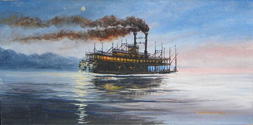

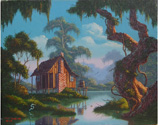
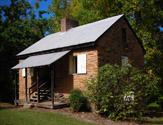









Magnolia Eden
The Chestnut Rose
A Unique Rose's Journey from the Far East to the American South
A Unique Rose's Journey from the Far East to the American South
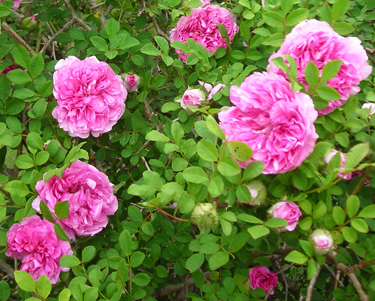
Well before the Suez Canal ("The Highway to India") expedited ocean travel from Europe to the Far East or the storied Orient Express passenger train traversed the Continent from Paris to Constantinople (modern-day Istanbul), European botanists, horticulturalists and traders journeyed throughout Asia, often exploring exotic locales never before accessed by Westerners in search of exciting plants and trees. Returning to the West with collected specimens and seeds in tow, many of their botanical treasures, including a plethora of roses from China and Japan, found their way to the American South where they flourish today.
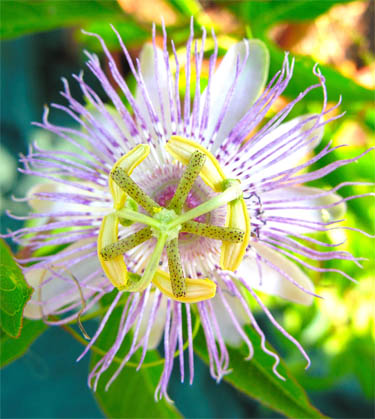
A Most Mysterious Discovery
Particularly unique among the Asiatic rose discoveries was China's Rosa roxburghii plena, a pink-fuchsia double commonly known as the chestnut or chinquapin rose due to its spiny, burr-like buds. Dr. William Roxburgh (1751-1815) found the rose growing in a garden in Canton in the early 1800s where it had been known for generations as "Hoi-tong-hong."
Originally named R. microphylla by Dr. Roxburgh in 1820, the chestnut rose's botanical name was changed in 1823 by the Austrian botanist Leopold Trattinick, because René Louiche Desfontaines had previously applied the name microphylla to an unrelated European species in 1798.
Roxburgh, an Ayrshire, Scotland native, was initially employed as a surgeon by the London-based East India Company, and later established gardens in Samalkot for the megacorporation. His newfound rose was taken to the Botanic Garden in Calcutta where he became the superintendent upon the death of its founder, Col. Robert Kyd (1746-1793). A keen plantsman, Roxburgh noted his observations and trained a number of native artists to execute botanical drawings and watercolor paintings, which served as the basis for the famous and now coveted books, Hortus Bengalensis (1814), a copy of which fetched $4,830 at Christie's auction house at New York in June 1997, and Flora Indica (1832). From the garden in Calcutta, specimens of R. roxburghii plena were taken to England in the early 1820s, and the rose was introduced in the United States in 1828.
There is some mystery surrounding R. roxburghii plena, an obvious offspring of the single-formed species, R. roxburghii. In his book, History of the Rose, Roy E. Shepherd wrote of R. roxburghii: "As the interior of China was inaccessible to Europeans in the early 1800's the garden form of this rose was discovered and introduced first. Its prototype, the single-flowered form, was found growing wild in Szechuan province, in 1814." Certainly, obvious similarities exist between the two, but experts have noted marked differences. Shepherd observed, "The fact that the double form is remontant and that the flowers are considerably darker in color than those of the single form, adds to the mystery of its origin."
Particularly unique among the Asiatic rose discoveries was China's Rosa roxburghii plena, a pink-fuchsia double commonly known as the chestnut or chinquapin rose due to its spiny, burr-like buds. Dr. William Roxburgh (1751-1815) found the rose growing in a garden in Canton in the early 1800s where it had been known for generations as "Hoi-tong-hong."
Originally named R. microphylla by Dr. Roxburgh in 1820, the chestnut rose's botanical name was changed in 1823 by the Austrian botanist Leopold Trattinick, because René Louiche Desfontaines had previously applied the name microphylla to an unrelated European species in 1798.
Roxburgh, an Ayrshire, Scotland native, was initially employed as a surgeon by the London-based East India Company, and later established gardens in Samalkot for the megacorporation. His newfound rose was taken to the Botanic Garden in Calcutta where he became the superintendent upon the death of its founder, Col. Robert Kyd (1746-1793). A keen plantsman, Roxburgh noted his observations and trained a number of native artists to execute botanical drawings and watercolor paintings, which served as the basis for the famous and now coveted books, Hortus Bengalensis (1814), a copy of which fetched $4,830 at Christie's auction house at New York in June 1997, and Flora Indica (1832). From the garden in Calcutta, specimens of R. roxburghii plena were taken to England in the early 1820s, and the rose was introduced in the United States in 1828.
There is some mystery surrounding R. roxburghii plena, an obvious offspring of the single-formed species, R. roxburghii. In his book, History of the Rose, Roy E. Shepherd wrote of R. roxburghii: "As the interior of China was inaccessible to Europeans in the early 1800's the garden form of this rose was discovered and introduced first. Its prototype, the single-flowered form, was found growing wild in Szechuan province, in 1814." Certainly, obvious similarities exist between the two, but experts have noted marked differences. Shepherd observed, "The fact that the double form is remontant and that the flowers are considerably darker in color than those of the single form, adds to the mystery of its origin."
Ed Harshaw
This intricate Passiflora incarnata bloom was photographed on June 27, 2006 in the garden of Southern Edition editor Greg Freeman by Lowcountry photographer Ed Harshaw. Harshaw's work was featured in the story, Ed Harshaw: Capturing the Splendor of the Lowcountry One Photo at a Time.
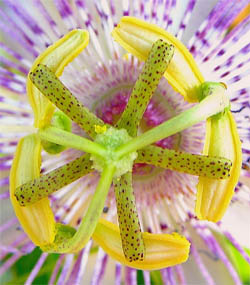
Ed Harshaw
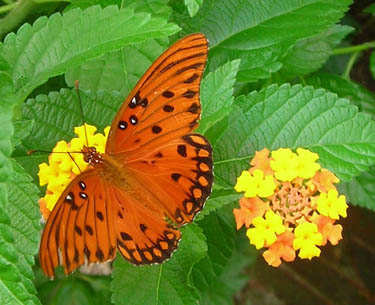
A Distinctive Garden Specimen
While it appears that rosarians must sustain some modern rose hybrids through diligent pruning, spraying and fertilizing, R. roxburghii plena is noted for its ease of care, strong disease resistance and tolerance of a wide range of soils. Whispering poetry in its ear is merely an option, not a requirement as mandated by fussier roses.
Typically growing five to seven feet in height and about five feet in width, the chestnut rose is further characterized by its peeling older wood and small, deep green, fern-like leaves that appear in groups of nine to fifteen. "Although not particularly fragrant," William C. Welch wrote in Antique Roses for the South, "the flowers are quite beautiful and occur over a long period."
Though rarely offered by commercial sources, the chestnut rose remains a most beloved treasure in the American South where it is still passed from one generation to the next. Still growing strong on old southern homesteads and even adorning the grounds of important gardens throughout the world, including the renowned Giardini di Ninfa (Gardens of Ninfa) in Italy's Lazio region just southeast of Rome, Rosa roxburghii plena is aesthetically appealing even when not in bloom. It is no wonder that Welch declared, "Few roses are as distinctive and useful as a specimen in the garden."
While it appears that rosarians must sustain some modern rose hybrids through diligent pruning, spraying and fertilizing, R. roxburghii plena is noted for its ease of care, strong disease resistance and tolerance of a wide range of soils. Whispering poetry in its ear is merely an option, not a requirement as mandated by fussier roses.
Typically growing five to seven feet in height and about five feet in width, the chestnut rose is further characterized by its peeling older wood and small, deep green, fern-like leaves that appear in groups of nine to fifteen. "Although not particularly fragrant," William C. Welch wrote in Antique Roses for the South, "the flowers are quite beautiful and occur over a long period."
Though rarely offered by commercial sources, the chestnut rose remains a most beloved treasure in the American South where it is still passed from one generation to the next. Still growing strong on old southern homesteads and even adorning the grounds of important gardens throughout the world, including the renowned Giardini di Ninfa (Gardens of Ninfa) in Italy's Lazio region just southeast of Rome, Rosa roxburghii plena is aesthetically appealing even when not in bloom. It is no wonder that Welch declared, "Few roses are as distinctive and useful as a specimen in the garden."
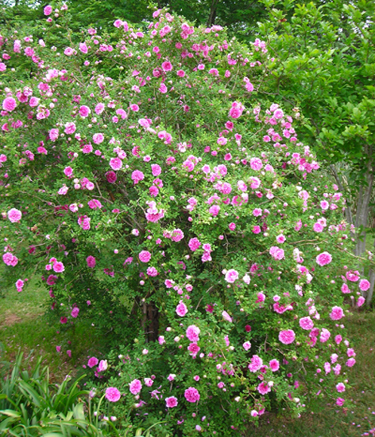
A Gulf Fritillary butterfly paying a visit to Lantana 'Miss Huff'
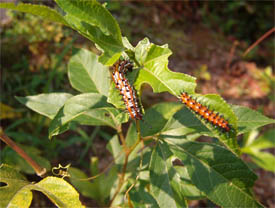
Author's Note: The specimen of Rosa roxburghii plena depicted in the accompanying photographs is the property of my good friend, Mary Winkler, who lives near West Union, South Carolina. Mary was born and raised in nearby Rabun County, Georgia where she says her mother, maternal grandmother and great-grandmother all grew the Chestnut rose. Her mother, Mattie Perry McCall (1909-2009)---very much reminiscent of Annie Nations, Jessica Tandy's Tony and Emmy Award-winning role in the 1982 Broadway production and 1987 film adaptation of Foxfire---was a humorous, self-reliant, strong-willed woman whose hard work and knowledge of Appalachian folkways made her a survivor.
One might ask how a rose from the gardens of Canton, China eventually wound up in the hills and hollers of North Georgia, but neither Mary nor I have a clue.
On an unrelated matter, it is interesting to note, however, that Mary's great-grandmother, Rebekah Cannonade Duncan, is believed to have been a granddaughter of John Miller (1730-1809), the London newspaper publisher and free press advocate who immigrated to Charleston in 1783, published South Carolina's first daily newspaper and established upstate South Carolina's first newspaper, Miller's Weekly Messenger.
One might ask how a rose from the gardens of Canton, China eventually wound up in the hills and hollers of North Georgia, but neither Mary nor I have a clue.
On an unrelated matter, it is interesting to note, however, that Mary's great-grandmother, Rebekah Cannonade Duncan, is believed to have been a granddaughter of John Miller (1730-1809), the London newspaper publisher and free press advocate who immigrated to Charleston in 1783, published South Carolina's first daily newspaper and established upstate South Carolina's first newspaper, Miller's Weekly Messenger.
Larvae of the Gulf Fritillary butterfly feeding on the leaves of Passiflora incarnata
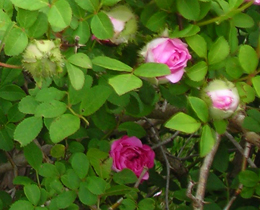
BIBLIOGRAPHY
Charles Quest-Ritson, Ninfa: The Most Romantic Garden in the World (London: Frances Lincoln, Ltd., 2009).
Roy E. Shepherd, History of the Rose (New York: The Macmillan Company, 1954).
William C. Welch, Antique Roses for the South (Dallas: Taylor Publishing Company, 1990).
"Gardens - East India Company," Plant Cultures: Exploring plants & people, Retrieved July 23, 2011: http://www.kew.org/plant-cultures
"SALE 8009/LOT 429," Christie's, Retrieved July 23, 2011: http://www.christies.com
Charles Quest-Ritson, Ninfa: The Most Romantic Garden in the World (London: Frances Lincoln, Ltd., 2009).
Roy E. Shepherd, History of the Rose (New York: The Macmillan Company, 1954).
William C. Welch, Antique Roses for the South (Dallas: Taylor Publishing Company, 1990).
"Gardens - East India Company," Plant Cultures: Exploring plants & people, Retrieved July 23, 2011: http://www.kew.org/plant-cultures
"SALE 8009/LOT 429," Christie's, Retrieved July 23, 2011: http://www.christies.com
Author: Greg Freeman. Published July 24, 2011.
Copyright
Southern Edition
All Rights Reserved
Southern Edition
All Rights Reserved
All materials contained on this site, including text and images, are protected by copyright laws and may not be reproduced without prior written permission from the publisher. Where applicable, use of some items contained on this site may require permission from other copyright owners.
Fair Use of text from SouthernEdition.com is permitted to the extent allowed by copyright law. Proper citation is requested. Please use this guide when citing a Southern Edition article.
Contact Greg Freeman or SouthernEdition.comFair Use of text from SouthernEdition.com is permitted to the extent allowed by copyright law. Proper citation is requested. Please use this guide when citing a Southern Edition article.